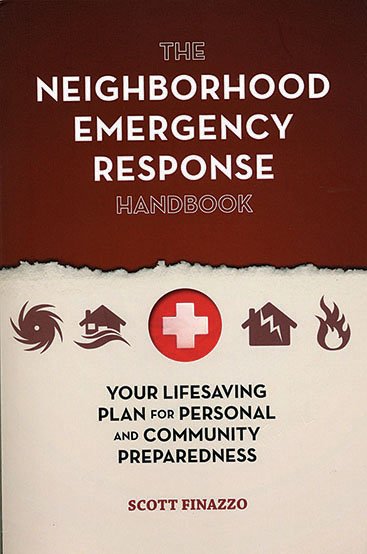The Neighborhood Emergency Response Handbook by Scott Finazzo (Ulysses Press paperback, 2015), 178 pages, $15.95
Why should we read this book when our taxes support many crews of fit, smart, passionate first responders who are going to be better equipped and better prepared than reading any book would ever, in a million years, make us?
Because sometimes trees are down across the road, and the ambulance can't get through right away.
Oh. OK, well, what can we learn from reading this book?
Enough to look around your home with an eye toward lessening the chances of your falling apart at the seams in response to some overwhelming disaster. Maybe you would be able to keep a wit or two about you while being overwhelmed.
Is this another book padded with way too many anecdotes about disasters the author has seen
or read about but about which the reader couldn't care less?
The book is organized with a nice balance of anecdote and instruction, although you will lose track of how often Finazzo tells you he's a second-generation emergency responder. But he covers a lot of ground:
• Common lingo used by fire and rescue crews across the nation.
• The main, most common threats to personal safety that homeowners should be able to manage in a disaster (where are the shut-off valves?) as well as tips about potential vulnerabilities it would be better not to discover in the middle of a forced evacuation from your home (recreational vehicles require a great deal of fuel, for instance).
• The Federal Emergency Management Agency's list of items to put into a disaster kit and a "bug-out" bag.
• Common-sense things to do to prepare your home for floods, storm, blizzards, earthquakes, tornadoes, civil unrest.
• A chapter on fire, including a nice tool for reading the codes on fire extinguishers and a handy household fire safety checklist (example: "Lamps and fixtures should not be in contact with any fabric.").
• Chapters about the basics of search and rescue, medical triage and supplies; advice for dealing with common injuries -- bleeding, burns, broken necks, backs and other bones (nice tip: Do not try moving a bone to test whether it is broken); and setting up a neighborhood network so you know the people you live near and have some shared idea of what to do if all heck breaks loose.
My favorite chapter is "Disaster Psychology," in which Finazzo prepares the neighborhood Superman to stand down: "Do not be offended if emergency responders arrive on the scene, thank you for your efforts, and relieve you from your position," he writes (as though such relief would ever be less than gratefully welcomed).
Who is the author? Scott Finazzo is a lieutenant in the Overland Park (Kan.) Fire Department who has been an instructor for community emergency response for 15 years. When his friends post comments on his professional-writer Facebook page, they say things like: "Dude, I didn't even know you could read ... let alone write like this!" But he is a writer. His adventure memoir, Why Do All the Locals Think We're Crazy? (self-published in 2014), documents a kayaking trip he and two friends survived in the Virgin Islands. Also in 2014, he co-wrote The Prepper's Workbook (Ulysses Press) with Scott B. Williams.
He has a bachelor's degree in management and human relations and two associate degrees. He and his family reside in Shawnee, Kan.
ActiveStyle on 09/21/2015
